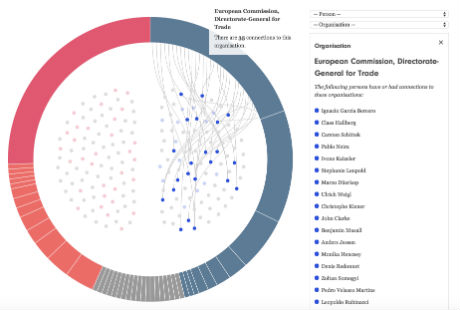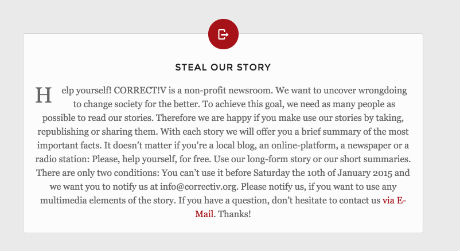Until a year ago, David Schraven was head of investigations at Funke Mediengruppe, one of Europe’s largest media holdings.
He was responsible for all the investigative reporting in the media group’s core markets in North Rhine-Westphalia, Germany.
He soon noticed it became harder to do large-scale investigations, especially the ones that expanded beyond the newspaper's geographical and technical capacities.
In order for Schraven to do investigative data journalism, he needed people able to do the “magic stuff with the data”, he said. But financial constrains at his newspaper made it difficult to get these guys on board.
“In traditional newsrooms it was hard to find people who where able to do this terrific work."
The alternative would have been hiring experts – but the financial uncertainty in the newspaper sector wouldn’t have allowed hiring externally.
This was the point Schraven decided there was a need for a different approach. With excitement, he watched what ProPublica managed to do with data journalism in the US, Mediapart achieved in France, or Newstapa did for South Korea.
His vision was to do something new, which was both similar to other international counterparts, yet had its own components. “Our approach is more focused on teaching and development”, he explained.
CORRECT!V impact behind the scenes
That was the birth of CORRECT!V, Germany’s only not-for-profit investigative newsroom. But not quite so quickly, as Schraven first had to find a way to finance the project.
He convinced donors in North Rhine-Westphalia to help him out, and the model today is pretty straightforward from the outside.
The extraordinary material CORRECT!V produces is given out for free, and it does not stop there. On a story about the Transatlantic Trade and Investment Partnership (TTIP) agreement for example, the organisation supported 15 local and regional newsrooms that didn’t have the resources to research and report on the story on their own.

The issue of little to no transparency for the TTIP agreement (and their dealers) which is currently negotiated was reported by CORRECT!V with a grounding in data, and presented through an interactive data visualisation. Image by CORRECT!V.
CORRECT!V and its true freedom to collaborate
The progress on the TTIP investigation is pretty good, Schraven said. The collaboration with the public allows him to work with new evidence, and now papers and documents are reaching the investigative newsroom.
Schraven thinks opponents to the transparency of the TTIP agreement “have already lost the war”.
For wider distribution, CORRECT!V also lets anyone reprint certain stories. Under the “steal our story” label, bloggers, newspapers or radio stations can republish stories, such as the investigation on the downing of flight MH17.

Screenshot from CORRECT!V.
CORRECT!V is able to collaborate with other news media because the point is, Schraven explained, that “CORRECT!V is no competition”.
If his organisation is giving out an investigative story for free, other news publications are able to sell it, so they are very eager to collaborate with him.
“We work together with big outlets in Germany such as Der Spiegel or Die Zeit, and we work with TV stations such as ARD, MDR or NDR, or private TV stations such as RTL. ”
This means is that whatever CORRECT!V investigates could influence which stories break in the entire German news media landscape.
CORRECT!V’s data journalism process
Data is at the core of all CORRECT!V investigations, Schraven said. When it comes down to what data really means, there are lots of different definitions.
For CORRECT!V, it can range from big data sets to publicly available air pollution data, to figures on traffic jams.
The process for investigative data journalism Schraven’s organisation follows includes three major steps.
“First of all we try to find out how to create a visualisation from it. We try to find a story in the big data sets, the key points, and what is important about all this data.
"Once we found the story, we try to find human beings who can talk about it and who have been affected by the issue we found,” he explained.
Sometimes data can be the start of Schraven’s stories, but the output could look completely different at the end.
One example is the story Weisse Wölfe, a documentary about Germany’s right wing extremism.We have different approaches once we have our hands on the data sets we need for our storiesDavid Schraven, CORRECT!V
The content is a breathtaking investigation of a Nazi terrorist group in Germany’s Ruhr region and the exposure of ties to other international networks. The core of all of that was big data, said Schraven.
“There were investigation records by the secret services, telephone files, and data from guys who did the surveillance.
"After I received all of this, I was looking for ways to tell the story and to make it not boring, but also to make my point and to reach out to an audience”.
In this case, Schraven decided not to tell the story in the old fashioned way but to produce a graphic novel. The work paid off and the project ended up a bestseller in Germany.
And yet again, data journaism can mean something completely different, he said.
In the case of the flight MH17 tragedy, Schraven’s team was looking for big data, and out of this data analysis, a search on the ground was possible.
“We knocked on doors and did the investigative ground work,” he said. In this case the data helped to find the right sources and witnesses, and made it possible to sniff in the right corners on the ground, enabling them to find the story they needed.
“We have different approaches once we have our hands on the data sets we need for our stories,” he explained.
For Schraven's journalistic vision, data is of crucial importance. In the end, a story might be published in a different way, but the starting point for the team is always the data.
Free daily newsletter
If you like our news and feature articles, you can sign up to receive our free daily (Mon-Fri) email newsletter (mobile friendly).









